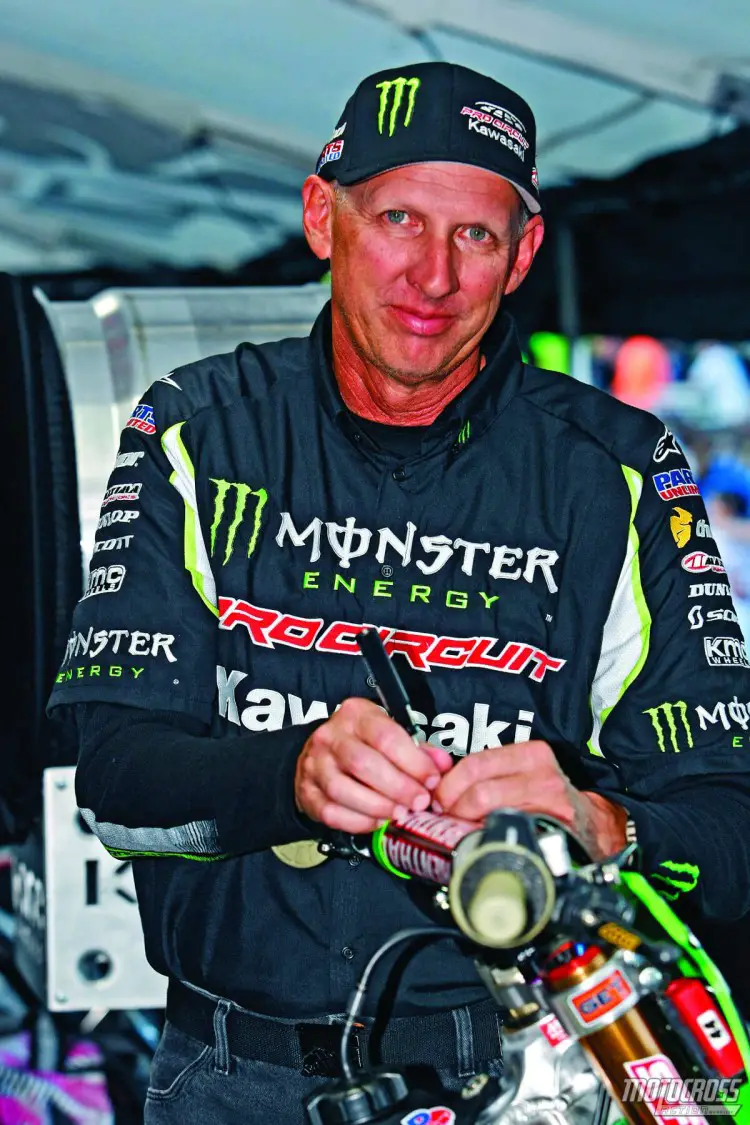BARE BONES: WHERE THE FAULT LIES IN YOUR SUSPENSION ISSUES
By Bones Bacon
You’re driving home from the races after a bad day. You’re trying to figure out why it all went wrong. Your conclusion? “It’s the suspension. It should be better. My bike beat me up. I got tired because my bike’s suspension wasn’t working well. I crashed because it kicked me.”
Trust me, I’ve heard it a thousand times. Here is a reality check. Only about 75 percent of what you feel when you are doing a post-mortem on how poorly your bike handled is suspension related. An equal part is chassis related and, believe it or not, to some degree you personally can affect how your bike handles.
Let’s start with how the chassis can affect handling. Some bikes, especially steel frame bikes, such as mini bikes, have frames that get stretched out from constant pounding. The more hours on the frame, the slacker every part of it becomes. At the factory level, we have jigs that we put our frames in to monitor geometry changes. We find that more than a few of our frames are stretched out, to the point where we can often see stretch marks in the paint. When a frame gets fatigued, the geometry changes enough that the steering angle, rake, trail, wheel base and chassis height are way out of tolerance — so much so that the bike couldn’t possibly handle the way it was designed to — no matter what you do to the suspension.
Aluminum frames are not immune to this phenomenon. All aluminum frames go through a break-in period where the chassis feels harsh, no matter what you do. Then, once the aluminum takes a set, the frame starts to feel good. Unfortunately, eventually the aluminum starts to fatigue and the bike gets bad. Some factory riders will take their practice bike frames, once they reach the sweet spot on the aluminum continuum, and use them on their race bikes. Then, after so many hours, the race frame is thrown away.
“I HAVE HAD RIDERS SAY THAT THEIR BIKE WASN’T WORKING RIGHT AT THE END OF THE DAY; BUT, THE NEXT MORNING, WHEN THEY WERE FRESH, THEY SWORE WE HAD PUT DIFFERENT SETTINGS IN BECAUSE IT HANDLED SO MUCH BETTER.”
Next on the list of why your bike feels bad are the miscellaneous parts that make a race machine. The torque of certain bolts, such as triple-clamp pinch bolts, motor mount bolts and swingarm pivot bolts, can change how a bike handles. Tire pressure increases as the race wears on, often as much as 4 pounds. This will change how your bike performs — especially if your tire pressure was a smidgen too high to begin with. How old are the tires on your bike? Rubber ages, and tire carcasses break down after a certain number of hours. I’ve been testing with factory riders who have sworn that something was wrong with their front forks. Yet, no matter what we changed it didn’t affect what they were feeling. As a last ditch effort, we changed the front tire, even though the one on the bike was relatively new. Lo and behold, they were suddenly 2 seconds a lap faster, and we had wasted hours chasing a problem that ended up being a tire. Triple clamps can also drastically affect how your bike handles. Not only the offset of the clamps, but the structure, stiffness and web thickness can make a bike feel different. Take this into consideration when you’re in the market for new clamps. It should be obvious that maintenance tasks, such as greasing the linkage, replacing worn parts, changing the rear axle position, gearing changes, lowering the fork tube height and misaligning the front axle can also make a big difference in performance.
Now, let’s put some of the blame on you. The better shape you’re in, the harder you can ride your bike and the more confidence you will have in general. This alone will affect how your bike feels when you ride it. I have had riders say that their bike wasn’t working right at the end of the day; but, the next morning, when they were fresh, they swore we had put different settings in because it handled so much better. We set our race teams’ suspension up for the ultimate test. If the rider doesn’t give it his all, the suspension will be wrong. In this case, the rider needs to man up and get in better shape. And, of course, there are always the strange stories. One year at Southwick, Jeremy McGrath won the first moto very easily on his Peak Honda. In the second moto, it looked like his bike handled poorly. Later we learned that between motos he was in the port-a-can the whole time as a result of a big bean and cheese burrito he ate the night before. He didn’t need better suspension, he needed a better diet.
The moral of this story is be open-minded about your bike’s performance. It isn’t always the suspension’s fault. Sometimes you have to take the blame.





Comments are closed.